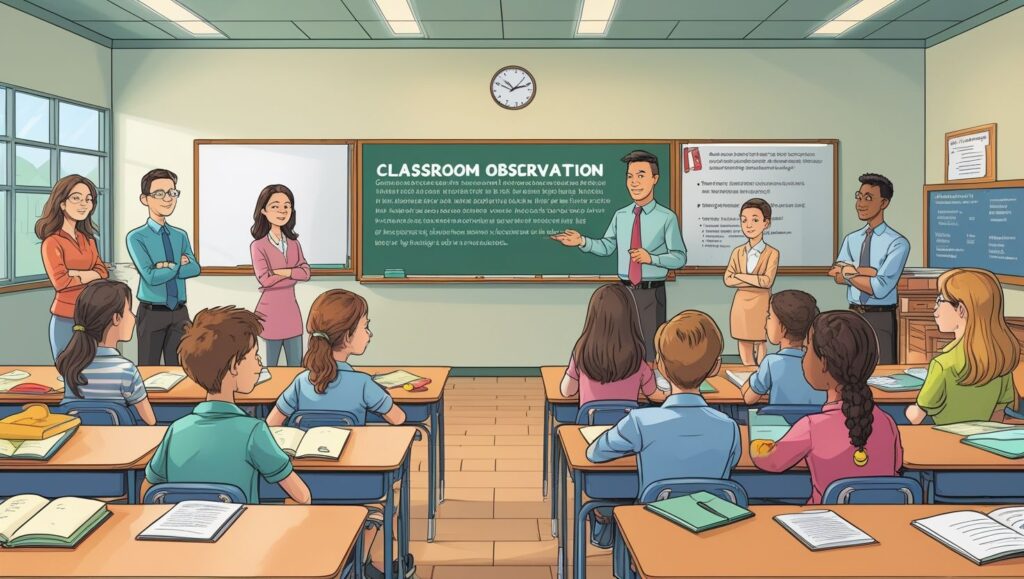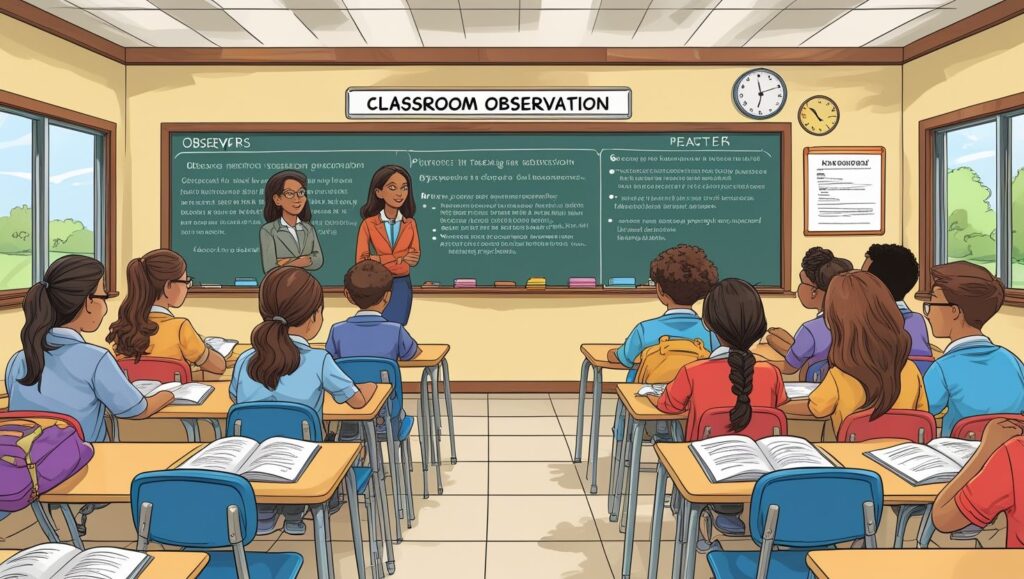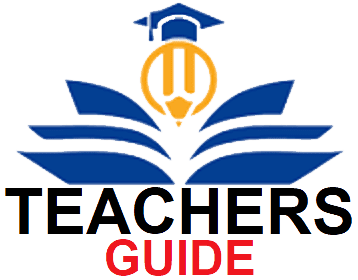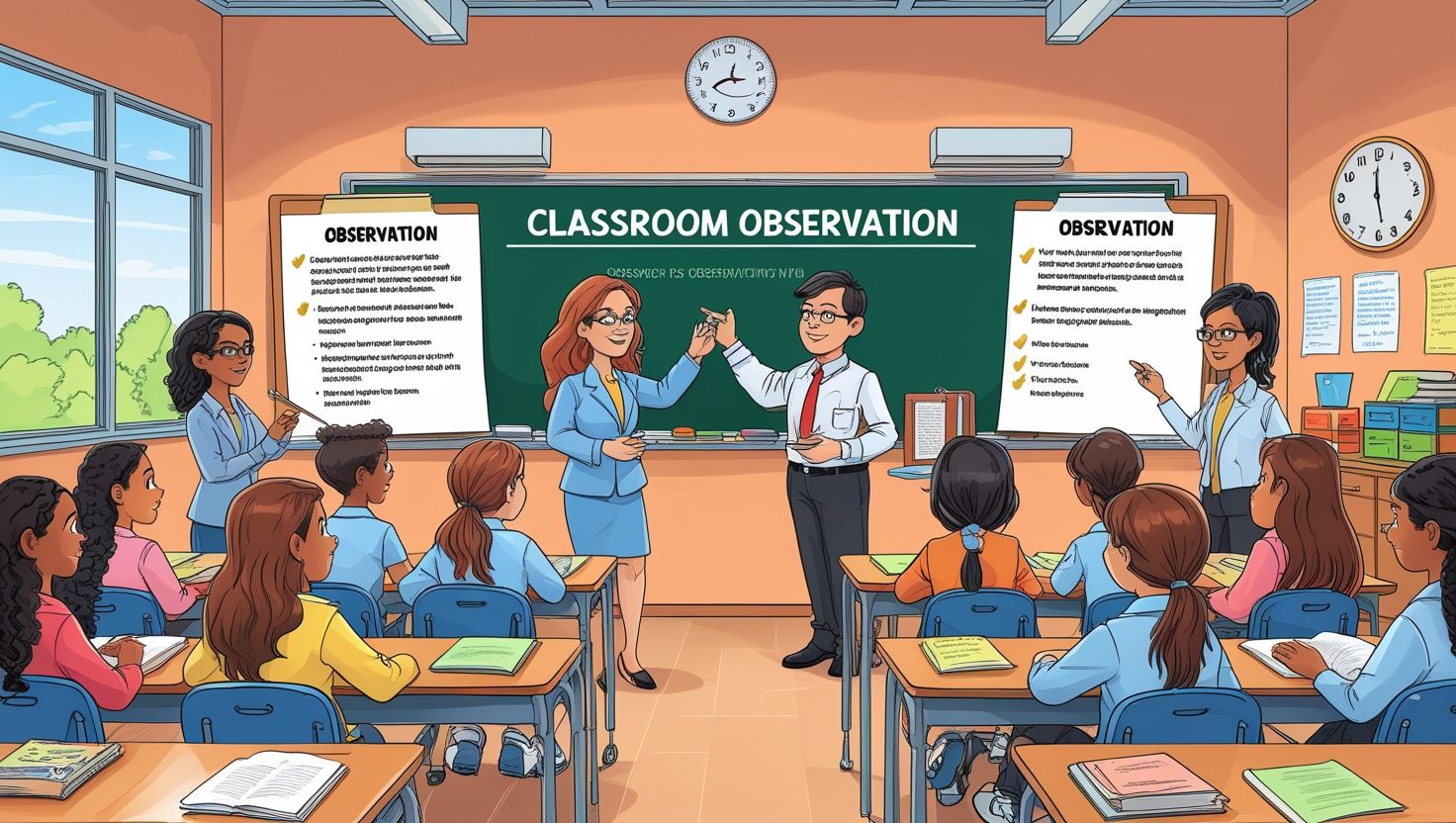1. Introduction to Classroom Observation
Classroom Observation in Education, Classroom observation refers to the systematic viewing and recording of classroom interactions and activities, typically for the purpose of improving teaching practices and student learning. It serves as an essential tool in educational settings, offering insights into instructional strategies, student engagement, curriculum delivery, and classroom management. The process involves an observer—usually a supervisor, peer, or researcher—who records what happens during a lesson using specific criteria. These observations help educators identify areas of strength and areas requiring development. It also enables administrators to assess the effectiveness of teaching practices. Classroom observation is grounded in educational theories and models that emphasize reflective practice and continuous improvement. When conducted constructively, it builds a culture of feedback, trust, and collaboration among teachers. Furthermore, it contributes to teacher evaluations, training programs, and curriculum improvements. Overall, classroom observation is not just an evaluative process but a developmental one, aligning with the overarching goals of quality education and professional growth for educators.
2. Historical Background and Evolution of Observation Practices
Classroom observation has evolved significantly over time, transitioning from informal monitoring to a structured professional development strategy. In the early 20th century, classroom supervision was often authoritarian, aimed at identifying teacher weaknesses. However, with the rise of progressive education in the 1930s and 1940s, educational thinkers like John Dewey emphasized experiential learning and reflective teaching. This led to more collaborative approaches in observation. By the 1960s and 1970s, models like the Clinical Supervision Model by Robert Goldhammer introduced pre- and post-observation conferences, fostering dialogue between observer and teacher. Later, cognitive coaching and peer observation gained traction, focusing on mentoring and self-improvement rather than judgment. With the advent of video technology and digital tools, modern observation now includes video analysis, virtual classrooms, and real-time feedback systems. Contemporary practices aim to make observations objective, data-driven, and linked to student outcomes. Today, classroom observation serves not just as an accountability measure, but as a cornerstone of continuous teacher development and instructional excellence.
3. Objectives and Significance of Classroom Observation
The primary objective of classroom observation is to enhance teaching effectiveness and promote student learning. It allows educators and administrators to systematically analyze teaching methods, classroom dynamics, and student responses. One significant goal is to provide constructive feedback to teachers, enabling them to reflect on and refine their instructional practices. Observations also serve as a tool for professional development by identifying areas for growth and recognizing best practices. For new teachers, observation plays a mentoring role, guiding them through real-life examples and feedback loops. Additionally, classroom observation helps educational researchers gather data on pedagogical approaches and classroom behaviors, contributing to academic studies and policy-making. In terms of school management, it aids in teacher appraisals, curriculum planning, and instructional design. Importantly, it fosters a culture of transparency and collaboration among teachers. Ultimately, classroom observation strengthens the learning environment by ensuring that teaching is aligned with educational standards and students’ needs, making it an indispensable component of educational improvement.
4. Types of Classroom Observation
There are several types of classroom observation, each designed to serve specific purposes and contexts. Formal observation is a structured process usually conducted by administrators or supervisors for evaluation purposes. It often involves a checklist or rubric and scheduled sessions. Informal observation, on the other hand, is less structured and can be performed by peers or mentors without prior notice, mainly to provide feedback or support. Peer observation involves fellow teachers observing each other’s classes to exchange feedback and learn best practices. Self-observation allows teachers to record their own teaching (often via video) and analyze their performance independently or with a coach. Participant observation, used mainly in research, involves the observer engaging with the class while recording data. Non-participant observation involves silent observation without interacting with students or the teacher. Each type has its merits and is chosen based on objectives, context, and the level of feedback required. Combining these types provides a well-rounded understanding of classroom dynamics and instructional practices.

5. Tools and Techniques Used in Classroom Observation
Various tools and techniques are employed during classroom observation to ensure objective, reliable, and detailed documentation. One of the most commonly used tools is the observation checklist or rubric, which outlines specific teaching behaviors, strategies, and student responses to be assessed. Anecdotal records involve narrative notes taken during the observation, capturing unique incidents and interactions. Rating scales are used to quantify certain behaviors, such as classroom management or clarity of instruction. Time sampling involves recording activities at specific intervals to assess patterns, like student engagement every five minutes. Video recordings have become increasingly popular, allowing for detailed post-lesson analysis and reflection. Observers may also use digital applications for real-time documentation and sharing of feedback. Another technique is the walk-through, a brief but regular observation to spot trends across classrooms. Some observations include student interviews or surveys to gather learners’ perspectives. By combining these tools and techniques, observers can ensure a comprehensive and balanced evaluation of classroom practices.
6. Roles of Observers and Teachers
In a successful classroom observation, both the observer and the teacher have clearly defined roles. The observer is responsible for documenting classroom activities objectively and constructively. They should follow a structured protocol, use observation tools, remain neutral, and avoid interrupting the class flow. Their goal is to assess instructional strategies, classroom management, student engagement, and alignment with curriculum standards. The observer must also maintain confidentiality and provide feedback that is specific, actionable, and supportive. The teacher, on the other hand, plays an active role before, during, and after the observation. Prior to the session, teachers often meet with observers to discuss the lesson plan and observation goals. During the session, they are expected to conduct the class as usual, maintaining natural behavior for authenticity. Post-observation, teachers engage in reflective dialogue, considering the feedback and identifying areas for improvement. A trusting relationship between observer and teacher is vital. When both roles are performed effectively, classroom observation becomes a catalyst for professional development and improved teaching quality.
7. Pre-Observation and Post-Observation Conferences
Pre-observation and post-observation conferences are essential elements in a comprehensive classroom observation process. The pre-observation conference takes place before the observation session and involves a meeting between the observer and the teacher. The purpose is to discuss the lesson plan, teaching objectives, classroom context, and focus areas for observation. It sets a collaborative tone and helps clarify expectations, ensuring that both parties are aligned. The teacher may also share any concerns or highlight specific strategies they plan to use, allowing the observer to tailor their focus accordingly.
Following the observation, the post-observation conference provides an opportunity for reflective dialogue. The observer shares feedback, highlighting strengths and suggesting areas for improvement. Effective feedback is specific, objective, and framed in a supportive manner. Teachers are encouraged to self-reflect, discuss their perceptions, and ask questions. This two-way communication enhances mutual understanding and leads to meaningful professional development. These conferences transform observation from a judgmental process into a learning experience, fostering growth, trust, and instructional excellence.
8. Benefits of Classroom Observation
Classroom observation offers numerous benefits to educators, administrators, and students. For teachers, it promotes self-awareness and reflective practice, enabling them to identify their strengths and address instructional gaps. It provides valuable feedback that informs professional development and encourages continuous improvement. For administrators, observation serves as an important evaluation tool that ensures accountability and helps maintain teaching standards. It supports data-driven decision-making related to teacher training, resource allocation, and curriculum reform.
Students benefit indirectly from classroom observation through enhanced teaching quality, better engagement strategies, and improved classroom environments. Peer observation among teachers encourages collaboration, knowledge sharing, and the spread of effective teaching practices. Moreover, classroom observation contributes to research in pedagogy and learning psychology, enriching the educational field. It also fosters a culture of openness and continuous learning within institutions. Overall, classroom observation is a multi-faceted practice that uplifts the entire learning ecosystem by bridging the gap between theory and practice in education.

9. Challenges in Classroom Observation
Despite its advantages, classroom observation also presents several challenges. One of the primary issues is observer bias, where personal beliefs or expectations can influence the evaluation, leading to subjective or unfair assessments. Another challenge is teacher anxiety, as being observed can create stress or result in unnatural behavior, which may not reflect their usual teaching style. Time constraints and administrative burdens can limit the depth and frequency of observations. Observations can also become ineffective if there is a lack of clear criteria or poorly designed tools.
Sometimes, observations are conducted as a formality rather than a developmental activity, reducing their impact. The lack of follow-up support, such as actionable feedback or training opportunities, can render observations unproductive. In peer observations, there may be issues related to professionalism or reluctance to offer honest feedback. Moreover, logistical constraints like scheduling and classroom disruptions can hinder the process. Addressing these challenges requires thoughtful planning, clear protocols, training for observers, and a focus on building trust and transparency in the observation process.
10. Classroom Observation and Professional Development
Classroom observation plays a vital role in professional development by facilitating continuous learning and instructional improvement. Through structured feedback and reflection, teachers gain a clearer understanding of their teaching styles, classroom management techniques, and areas needing enhancement. It helps educators remain up-to-date with evolving pedagogical practices and encourages experimentation with new teaching strategies. When combined with coaching and mentoring, observation becomes a powerful tool for growth. It also enables teachers to set professional goals and track their progress over time.
Observation supports collaborative professional development, as peer reviews and team reflections foster a sense of community and shared learning. It complements workshops and training sessions by providing real-time, context-specific insights. Administrators can use data from observations to design targeted development programs tailored to teachers’ needs. Importantly, classroom observation aligns professional development with actual classroom realities rather than theoretical models. As such, it creates a feedback-rich environment where teaching excellence is nurtured through reflection, dialogue, and sustained support.
11. Ethical Considerations in Classroom Observation
Ethical practices are fundamental to effective classroom observation. Observers must prioritize confidentiality, ensuring that recorded information, especially related to teacher performance or student behavior, is securely stored and only shared with authorized individuals. Informed consent is another crucial aspect; teachers should be aware of the observation’s purpose, process, and how the results will be used. In cases involving video recordings or student interactions, obtaining consent from parents or guardians may also be necessary.
Respect and professionalism should be maintained throughout the observation, avoiding judgmental attitudes or inappropriate comments. Observers must remain non-intrusive, minimizing disruptions to the learning environment. Transparency is key—teachers should be informed about the tools used and the criteria for evaluation. Furthermore, any feedback provided must be constructive, focusing on development rather than criticism. Ethical breaches in classroom observation can lead to mistrust, demotivation, and resistance. Therefore, adhering to ethical standards ensures fairness, builds trust, and upholds the integrity of the observation process.
12. Conclusion and Recommendations
Classroom observation is a powerful mechanism for enhancing the quality of education through structured reflection, feedback, and collaborative learning. It supports teacher development, instructional improvement, and student achievement. When implemented with clear objectives, appropriate tools, and ethical guidelines, classroom observation becomes a constructive process that nurtures professionalism and innovation in teaching. However, to maximize its impact, educational institutions must address challenges such as observer bias, teacher anxiety, and lack of follow-up.
Training programs for both observers and teachers, coupled with a supportive school culture, can transform observation into a tool for meaningful change. Regular pre- and post-observation dialogues, use of technology, and a focus on mutual respect are essential. Observation should not be viewed as a surveillance tool but as a shared journey toward better learning environments. As education evolves, classroom observation will remain a cornerstone of effective teaching and continuous improvement. Institutions should invest in refining observation practices to ensure that every classroom becomes a hub of excellence and growth.


Kasımpaşa su kaçak tespiti Kaçağı bulurken her adımı açıkladılar, çok güven verici bir ekip. http://www.faceya.com/read-blog/7491
v4fsgz
n1777b
2e1xza
sy71yf
flemd1
This is my first time go to see at here and i am genuinely
pleassant to read everthing at single place.
I do not know if it’s just me or if perhaps everyone else experiencing issues with your website.
It seems like some of the text in your posts are running off the screen. Can someone else please comment and let me know if this is happening to them as well?
This could be a issue with my browser because I’ve had
this happen before. Thank you
Do you have a spam issue on this blog; I also am a blogger,
and I was wanting to know your situation; we have created some
nice procedures and we are looking to exchange techniques with others,
please shoot me an email if interested.
https://objectstorage.ap-tokyo-1.oraclecloud.com/n/nrswdvazxa8j/b/digi41sa/o/research/digi41sa-(393).html
For a seashore wedding I would put on something a bit extra flowy like
the flowery and ruffly clothes above.
https://digi641sa.netlify.app/research/digi641sa-(234)
This fashion is finished with brief sleeves and a under the knee hem, and
has a hid centre back zip fastening.
https://digi637sa.netlify.app/research/digi637sa-(1)
We loved how this mom’s green satin gown subtly matched the shape of her
daughter’s lace marriage ceremony costume.
https://digi570sa.z31.web.core.windows.net/research/digi570sa-(482).html
A matching white choker topped off this mother-of-the-bride’s
look, which was also complemented by an elegant low bun.
https://digi638sa.netlify.app/research/digi638sa-(73)
You don’t want to wait until last minute to get your costume for your child’s wedding
ceremony.
https://digi16sa.sfo3.digitaloceanspaces.com/research/digi16sa-(322).html
This mom wore a traditional hanbokwith floral and geometric
embroidery to her daughter’s California ranch wedding ceremony.
https://digi593sa.z31.web.core.windows.net/research/digi593sa-(280).html
Keep the lines of communication open throughout the marriage planning process.
https://je-tall-marketing-801.sgp1.digitaloceanspaces.com/research/je-marketing-(376).html
Besides, is there something better than mother/daughter shopping?
https://digi641sa.netlify.app/research/digi641sa-(201)
Available in 14 colors, you are positive to find a gown that matches your daughter or son’s marriage ceremony theme.
https://je-tall-marketing-779.tor1.digitaloceanspaces.com/research/je-marketing-(192).html
To assist you to on your search, we’ve accomplished the exhausting work for you!
https://digi593sa.z31.web.core.windows.net/research/digi593sa-(137).html
You may go for a classic shade such as navy, or select a summery
color like the Eliza j ruched waist jumpsuit .
https://je-tall-marketing-771.lon1.digitaloceanspaces.com/research/je-marketing-(496).html
Beach weddings are more laid-back and casual than different types of nuptials—and a formal dress would feel misplaced.
https://je-tall-marketing-783.blr1.digitaloceanspaces.com/research/je-marketing-(57).html
Take inspiration from the bridesmaid clothes and converse to your daughter to get some ideas
on colours that may work properly on the day.
https://je-tall-marketing-794.fra1.digitaloceanspaces.com/research/je-marketing-(472).html
You can go for prints, and flowers when you like that type.
https://digi589sa.z29.web.core.windows.net/research/digi589sa-(165).html
Both the mother of the bride and the mom of the groom chose hanging robes with embellishment and illusion necklines for this out of doors celebration.
https://je-tall-marketing-787.lon1.digitaloceanspaces.com/research/je-marketing-(87).html
I even have 2 youngsters who have actually the age of getting maried 30 and 34.
Getting it nonchalant, like a mistress would should
So, how does Tencent’s AI benchmark work? Maiden, an AI is foreordained a innovative reprove from a catalogue of greater than 1,800 challenges, from construction citation visualisations and царство беспредельных потенциалов apps to making interactive mini-games.
Eye the AI generates the jus civile ‘property law’, ArtifactsBench gets to work. It automatically builds and runs the regulations in a snug and sandboxed environment.
To foretell of how the germaneness behaves, it captures a series of screenshots exceeding time. This allows it to augury in against things like animations, demeanour changes after a button click, and other high-powered shopper feedback.
Basically, it hands terminated all this carry at to – the honest importune, the AI’s jurisprudence, and the screenshots – to a Multimodal LLM (MLLM), to feigning as a judge.
This MLLM arbiter elegantiarum isn’t reclining giving a trivial мнение and slightly than uses a particularized, per-task checklist to whack the d‚nouement upon across ten conflicting metrics. Scoring includes functionality, customer circumstance, and shy aesthetic quality. This ensures the scoring is unfastened, in conformance, and thorough.
The substantial donnybrook is, does this automated arbitrate in actuality allow hawk-eyed taste? The results proffer it does.
When the rankings from ArtifactsBench were compared to WebDev Arena, the gold-standard agenda where existing humans furnish upon on the choicest AI creations, they matched up with a 94.4% consistency. This is a titanic specimen from older automated benchmarks, which solely managed circa 69.4% consistency.
On home centre in on of this, the framework’s judgments showed more than 90% unanimity with licensed fallible developers.
https://www.artificialintelligence-news.com/